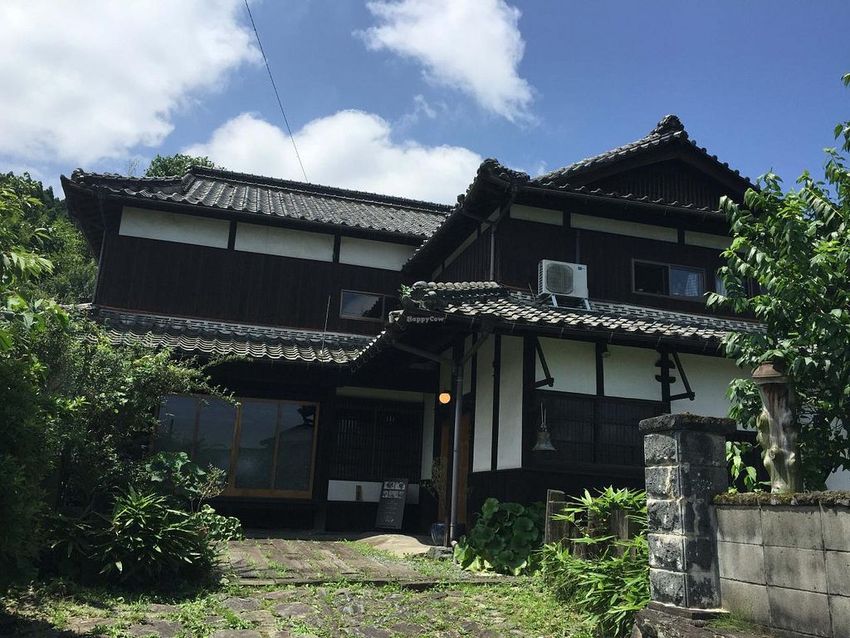"The true sage is concerned not with the cure of disease but with its prevention." Often, the road least traveled is the road that leads to enlightenment and nutritional freedom. During our time in Fukuoka, Japan, my wife and I visited the top macrobiotic (vegan) restaurants in the area. One of our most exceptional experiences included Haze Rouge, which sits an hour outside of the city in the Mino Mountain Range. Applying balance to foods that heal is the core principle of the macrobiotic lifestyle.
We discovered Haze Rouge by searching the Happy Cow app for vegan places while visiting family in Fukuoka. It was a no-brainer to venture out on a day trip to the 120-year-old traditional Japanese house turned macrobiotic restaurant. Tucked away in the countryside of Kurume, Kyushu, the adventure was both culinary and cultural through a land where locals grow their own foods from wheatgrass and rice to cabbage and persimmons. The sunny Sunday morning excursion brought us beauty and serenity in route to some of the most delectable plant foods we have tasted to date.
Open from 11:30 am to 3:00 pm (the last order is at 2:30 pm) Wednesday through Sunday for lunch, then from 6 pm to 8 pm for dinner (reservations required), Haze Rouge is run by macrobiotic chef Hirata Atsushi. Initially based in Tokyo, Hirata explained during our brief conversation that he relocated to Kyushu for the fresh vegetation. Macrobiotics (health, food, and energy) was originated by Dr. Sagen Ishizuka and spearheaded by George Ohsawa with the underlying philosophy incorporating locally grown whole grains as the core dietary staple along with veggies, fermented soy, legumes, seaweed, and fruit intermixed with the Chinese principle of yin and yang. These grains could be brown rice, soba (buckwheat), millet, oats, quinoa, spelt, rye, or teff, to name a few.
We decided to travel by public transportation as opposed to fetching a ride from Misa's relatives. The trip took approximately 75 minutes, kicking off from the Nishitetsu Fukuoka Station on the Nishitetsu Tenjin Omuta Line towards Omuta. This express train sees only three stops, and in 30 minutes, you will get off at the Kurme Station and walk downstairs to the bus terminal. Stand in Kiosk 3 for bus 20 towards Yoshii Eigyosho and ride it roughly 17 minutes and 13 stops until you reach the Dairobaru stop. You could also take bus 25, which drops you off closer to Haze and reduces trip time by 10 to 15 minutes. However, we wanted the extra workout and opted for the 1-mile walk. I'm always looking for additional activity when traveling. Plus, the country's views and landscapes were meditative and naturalistic.
Ahead of time, we arrived before our reservation slot and hung out front snapping photos and guessing the names of various plants and fruits. Upon entering, our shoes came off and the host seated us at a table next to a sliding door/wall which opens to the pristine courtyard. Misa began speaking Japanese, though our host was fluent in English. However, the menu is written in Kanji, which she doesn't read. The various dining rooms are laden with Tatami (bamboo) floors and separated by traditional rice paper doors that slide open/close. Soft Jazz reverberated throughout the venue to set the congenial dining mood. Furthermore, Haze sells a cadre of macrobiotic foods such as Farro, seaweed, and oats.
Since I didn't foresee another visit soon, all three featured meals were selected to experience a wider variety of their offerings. The surprise was how favorable the portions were in comparison to other macrobiotics restaurants such as Evah with minuscule servings. Our ensemble consisted of the following and costs ¥5500, which was roughly $55 to $60:
• My first dish was a homemade soy yogurt with veggies and fruits (tomato, mushrooms, okra, oranges, peas, pears, and flaxseed), and her plate was a green salad with tomatoes and peas topped with a fermented soy dressing.
• The second dish was corn and brown rice soup before the three aforementioned main courses were served.
• Main Dishes:
◦ Ancient Farro pesto pasta simmered in tomato sauce.
◦ Tofu burger layered with zucchini, tomato, and smothered in a bean sauce (no bread).
◦ Spicy chili curry over brown rice that was reminiscent of cumin or turmeric. The waiter later confirmed it was indeed turmeric.
• After the tofu, pasta, and curry, an ensemble of brown, rice, miso soup, and Tsukemono (Japanese preserved veggies) were served.
• Lastly, Haze presented a macrobiotic dessert of coconut ice cream over peaches and berries.
• Green tea is replenished throughout the dining experience.
After lunch, discover more of the mountain area by visiting Kurume Forest Azalea Park for a hike on any of nine nature trails while intoxicating yourself from the 100 varieties and 61,000 bulbs of Kurume azaleas, maple trees, and cherry blossoms in the park. Indeed, this was not just another vegan visit, but more of a permanent marker in our catalog of nomadic journeys for life enhancement and uplifting our conscience. Enjoy!













